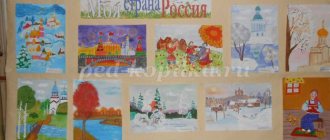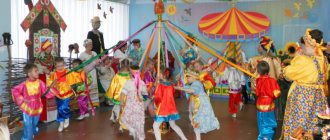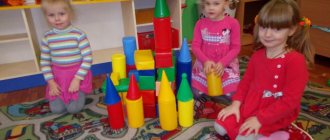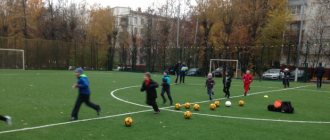Didactic games for the development of children's theatrical abilities. - presentation
Didactic games for developing children's theatrical abilities
Contents Didactic game “Guess the fairy-tale hero” Didactic game “Visiting a fairy tale” Didactic game “Guess the bell” Didactic game “Flower Music”
Didactic game “Guess the fairy-tale hero” Purpose: To consolidate children’s knowledge about the heroes of their favorite fairy tales. Develop speech, intonation expressiveness, imagination, and the ability to analyze the actions of fairy-tale characters. Progress of the game: The teacher invites the children to listen to a short quatrain about a fairy-tale hero. Children must guess the hero from the fairy tale and, with the help of facial expressions and gestures, convey the characteristics of his character.
Round, tasty and ruddy, He did not listen to mom and dad. Straight from the stove, jump and gallop, rolled away... KOLOBOK
The bun rolled off the porch and set off along the path into the forest. Following him, with a click of his teeth, a hungry man jumped out... WOLF
Everyone in the forest is afraid of the wolf, he loves to bite. Walks in soft slippers He is behind the red... Little Red Riding Hood
Grandfather Mazai is floating along the river. And along the shore on the stove He just rides without a goal Good fellow... Emelya
The whale shoots up fountains, And an eagle flies above it - The Good Doctor is in a hurry to Africa... Aibolit
The Firebird has a long tail. He has a secret, he is not simple. Only one knows what is in the tail and how... Ivan is a fool
The robber has a girlfriend, whiles away her life in a hut. The one on chicken legs and is called... Grandma Yozhka
All bears love honey. Use your paw to remove it from the honeycomb. That this rumor is true. Winnie the Pooh will prove it to you
Winnie the Pooh sings sawdust, There is sawdust in his head, There is a badge on his chest. And on it is a friend... Piglet
Didactic game “Visiting a fairy tale” Purpose: To consolidate children’s knowledge about their favorite fairy tales. Develop speech, memory, thinking, imagination, the ability to analyze the actions of fairy-tale characters. Progress of the game: An adult invites the children to split into two teams (a team of boys and a team of girls) and reads them an excerpt from a fairy tale they know. Children guess the fairy tale. Whose team was first gets a chip. The team with the most chips wins.
“Kolobok” He left his grandmother, And he left his grandfather, And he left the hare, the wolf, the bear, A round, mischievous boy.
“Doctor Aibolit” He treats mice and rats, Crocodiles, hares, foxes, Bandages the wounds of an African monkey. Never rests. He saves everyone day and night.
“Pinocchio” The wooden mischief-maker came from a fairy tale into our lives, A favorite of adults and children, A daredevil and an inventor of ideas. On land and under water, Looking for a golden key
“Cinderella” I wish the evening would quickly approach, And the long-awaited hour would come, So that I could go to a fairy-tale ball in a gilded carriage! No one in the palace will know where I come from or what my name is, But as soon as midnight comes I will return to my attic.
“Little Red Riding Hood” Grandmother loved the girl very much and gave her a red riding hood. The girl forgot her name. Well, tell me her name!
“The Three Little Pigs” The nose is round, with a snout, It’s convenient for them to dig in the ground, The tail is small with a hook, Instead of shoes - hooves. Three of them - and how alike the friendly brothers are. Guess without a hint, who are the heroes of this fairy tale?
“Three Bears” Near the forest, on the edge, Three of them live in a hut. There are three chairs and three mugs, three beds, three pillows. Guess without a hint, who are the heroes of this fairy tale?
Multimedia didactic game “Journey to the world of theater”
Participants of the exhibition and competition:
Renzanova Olga Petrovna, teacher
Solodenko Natalya Yurievna
Senior teacher, highest qualification category
MADOU d/s No. 183 of the city of Tyumen
Multimedia didactic game “Journey to the world of theater”
"Journey into the world of theater"
Goal: to introduce preschoolers to theatrical art by solving computer problems on the topic “Theatre”.
Tasks:
“Artistic and aesthetic development”:
- · Develop an interest in theater arts.
- To develop the skill of creating an artistic image using theatrical expressive means (make-up, costume, etc.)
"Cognitive development":
- Strengthen children's understanding of the theater.
- Learn to establish cause-and-effect relationships between objects and phenomena.
- Develop the ability to model in the form of a theater poster.
- Develop computer skills and solve didactic problems.
“Speech development”:
- Activate your child’s vocabulary with theatrical terminology
- Improve the grammatical structure of speech when forming words with the same root (make-up - make-up artist, ticket-ticker, etc.)
- Cultivate interest in literary characters and literary works.
“Social and communicative development”:
- · Develop an interest in theatrical professions.
Multimedia didactic game allows you to:
- stimulate learning motivation;
- enrich the visibility of learning;
- review previously covered material;
- use as a final quiz game.
The computer game is based on didactic games: “The 3rd odd one”, “What did the artist mess up”; riddles, verbal and didactic game “Name the profession”, task for modeling a theater poster, dynamic pause - physical minute.
The multimedia didactic game “ Journey to the World of Theater ” is intended for children aged 5-7 years. Can be used by teachers in kindergartens in individual work with children of senior preschool age, parents for individual training at home.
Development program: Power Point
Equipment: screen, projector, laptop.
Rules of the game:
- Riddles or questions are written on the slides. It is necessary to explain the answer and click with the mouse to receive confirmation that the answer is correct, or select an answer option and click with the mouse on the selected option.
- If the answer is correct, you will hear a corresponding voice message.
- To go to the next slide, click on the “>” button in the lower left corner.
Usage form:
- individual work with a computer.
Method of use:
- a multimedia didactic game is used for individual learning;
- Based on the results of the completed task, the child receives verbal encouragement “Well done! Perfect!" and setting for the next task;
- Upon completion of all tasks, the child receives a reward - a musical postcard.
Educational effect:
ü Enrichment of vocabulary, development of coherent speech, development of word formation functions.
ü Learn to guess theater-themed riddles.
ü Learn to determine the month, date, day of the week and time by description.
ü Development and correction of cognitive processes: visual, auditory perception, memory, attention.
ü Revealing the ability to exclude and generalize based on identifying the essential features of objects.
Game difficulty:
The teacher has the right to expand the didactic computer game with the following tasks:
— seat the spectators according to the tickets. Task: Formation of the skill of ordinal counting within 20, the skill of orientation in space.
— expand knowledge about theater professions;
-add a slide – a task in which the preschooler needs to put on the actor’s makeup, choosing blush, mustache, nose, wig, etc.;
-expand knowledge about different types of theater. Several slides are introductory, the rest are in the form of games “4th odd”, “Find a pair”.
Variation of the game:
The variability of the game may depend on the goal:
- about knowledge of theater professions.
— to solve cognitive (mathematical) problems.
- knowledge of types of theater;
- knowledge of a literary work or characters, etc.
Based on the results of completed tasks, the child can be offered stickers, badges or other collectible material. If there is a certain amount of this reward material, the child moves to the second stage, etc.
Description:
(Slide 1) Title. The name of a didactic computer game.
(Slide 2) Inviting a preschooler to participate in the game.
(Slide 3) The preschooler needs to use a riddle to find out who is inviting him on a trip to the theater.
(Slide 4) The hero invites the preschooler to create a theater poster.
(Slide 5-9) The preschooler needs to establish cause-and-effect relationships between phenomenon, action, time and design a theater poster.
(Slide 10) The preschooler is asked to perform a dynamic pause - a physical minute.
( Slide 11) The preschooler is offered the game “Third Wheel”. Task: find a puppet theater.
(Slide 12-16) The preschooler needs to name theater professions. By guessing riddles - clues. The child is faced with the task of forming words with the same root (for example, make-up - make-up artist)
(Slide 17) Based on the results of the completed task, the child receives verbal encouragement “Well done!”
(Slide 18-20) The preschooler needs to determine what the designer got wrong when depicting the characters in the theatrical performance.
(Slide 21) Based on the results of the completed task, the child receives verbal encouragement “Excellent!” and setting up for the next task.
(Slide 22-23) The preschooler needs to determine the elements of the costume of the main character - Pinocchio.
(Slide 24) Based on the results of the completed task, the child receives a reward - a musical postcard.
Video of the game organization
Dear adults!The game is intended for the emotional and intellectual development of children aged 5-9 years. Children become familiar not only with the names and characteristic external features of the 8 basic (innate) emotions, but also learn to distinguish and compare emotional sensations, both their own and those of others. Mood is a stable experience of emotions. By playing with emotions, kids will learn to control their own mood, which will positively affect their relationships with the outside world. In our theater there are 8 main roles: Interest, Joy, Surprise, Sadness, Anger, Disgust, Fear, Guilt, presented in the form of masks. In addition, 4 characters participate, by whose appearance children must determine their role and emotion. The game develops voluntary attention and thinking and is suitable for those who can read and those who are learning to read.
GAME COMPLETENESS:
1. 8 mask cards;
2. 4 cut cards with characters (32 pieces);
3. Envelope for cards;
4. Rules.
Cut the paired mask cards in half into separate cards, and the character cards into small cards (32 pieces).
RULES OF THE GAME
OPTION 1.
Invite the children to carefully examine the mask cards and draw their attention to the variety of external signs of the manifestation of emotions, their differences and similarities. Talk about when a particular emotion arises. Distribute the mask cards equally among the players. Let everyone try to depict this emotion on their face. The presenter shows small cards one at a time, choosing at random. Children must collect 4 cards for their mask with characters experiencing the same mood: cards with joyful characters are collected for the mask of joy, cards with sad characters for the mask of sadness, etc. The one who collects his heroes faster than others wins.
OPTION 2. "One actor theater"
This game only involves single cards. The players' task is to collect all the pictures related to one character. The presenter distributes one card with a hero. After this, the players take turns passing the rest, one card at a time, to their neighbor on the left, in a circle, one at each turn. The player keeps cards that are suitable in content. The first one to collect his character's emotions wins.
OPTION 3. "Master Class".
Put on an impromptu performance!
The game involves all cards and cards that are folded together, face down. Players take turns choosing a card or card and, without revealing its contents to other players, depict this emotion and character. The rest of the participants guess the mood by facial expressions and pantomimes.
The one whose performances were more successful and understandable wins.
4 OPTION. "Golden Mask".
Only mask cards are used in the game. They can be cut along the lines into 4 parts. These parts are turned over and mixed. Children, choosing one at a time, must reassemble the mask. The one who collects the mask the fastest wins.






